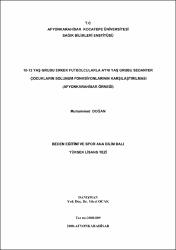| dc.contributor.advisor | Ocak, Yücel | |
| dc.contributor.author | Doğan, Muhammed | |
| dc.date.accessioned | 2015-04-10T07:11:23Z | |
| dc.date.available | 2015-04-10T07:11:23Z | |
| dc.date.issued | 2008 | |
| dc.date.submitted | 2008 | |
| dc.identifier.uri | http://hdl.handle.net/11630/3756 | |
| dc.description.abstract | Bu araştırmada; 10-12 yaş grubu erkek futbolcu öğrenciler ile aynı yaş grubu sedanter öğrencilerin akciğer hacim ve kapasitelerinin arasındaki farklılıkların belirlenmesi amaçlanmıştır. Araştırmamıza Afyonkarahisar il merkezinde okuyan 152 erkek öğrenci gönüllü olarak katıldı. Futbolcular ve sedanterler olmak üzere iki grup oluşturuldu. Futbolcu grup en az iki (2) yıl düzenli olarak okul veya kulüp takımlarında futbol oynamış olanlardan oluşturulurken sedanter grup da herhangi bir şekilde aktif olarak spor yapmayan çocuklardan oluşturuldu. Futbolcu çocukların (n:76) ortalama olarak yaşları 11.53±0.5 yıl, boyları 148.16±7.58 cm., vücut ağırlıkları 39.24 ± 6.78 kg. iken sedanter çocukların (n:76) ortalama yaşları 11.46±0.5 yıl, boyları 146.58 ± 6.80 cm. ve vücut ağırlıkları da 37.82 ± 4.71 kg. olarak belirlendi. Araştırmamızda Koko legend marka spirometre kullanıldı. Akciğer hacim ve kapasitelerinden Zorlu Ekspirasyon Volüm (FVC), Bir Saniyede Zorlu Ekspirasyon Volüm (FEV1) ve Bir Saniyede Zorlu Ekspirasyon Volüm ile Zorlu Vital Kapasite Oranı (FEV1/FVC) ölçümleri yapıldı. İstatistiksel analizlerinde SPSS 11.5 paket programında aritmetik ortalamaları, standart sapma değerleri belirlendi. Gruplar arası karşılaştırmada İndependent t-testi ve korelasyon testi uygulandı. Veriler t-testinde 0.05, korelasyonda ise 0.01 anlamlılık seviyesinde değerlendirme yapıldı. Akciğer dinamik hacimlerinin ortalaması FVC futbol oynamayan grup için 2.65±0.2 lt. iken futbol oynayan grup’ta 2.75±0,3 lt’dir. FEV1 değerleri ise futbol oynamayan grup için 2.3±0,2 lt. iken futbol oynayan grup’ta ise 2.4±0.2’ lt. dir. Bu farklılıklar istatistiksel olarak ta P<0.05 seviyesinde anlamlılık ifade etmektedir. FEV1/FVC de futbol oynamayan grup için 0.8±0.1 iken futbol oynayan grup da ise 0.1±0.1 dir. FEV1/FVC değerleri arasında anlamlı bir fark görülmemiştir (p>0.05). Futbol oynayan grubun akciğer kapasiteleri sedanter gruptan daha iyi olduğu gözlendi. Sonuç olarak, aktif olarak futbol oynayanların akciğer hacim ve kapasitelerinin sedanter çocuklara göre daha iyi düzeyde olduğu görülmüştür. Elde edilen verilere dayanarak futbolun akciğer hacim ve kapasitelerini olumlu etkilediği söylenebilir. | en_US |
| dc.description.abstract | The purpose of this study is to define the differences of the respiratory volume and capacities of 10 to12 years old students who play football at school or club teams at least 2 years and who do not play sports. 152 volunteer boys who go to school in the centre of Afyonkarahisar city attended to this study. Two groups were formed. Football player boys group and sedentary group. Football player boys group composed of boys who played football regularly at school or club teams at least 2 years and sedentary group boys who did not play any sports. The mean age, height and weight of football player boys ( n:76 ) and sedentary boys ( n:76 ) were 11.53 ± 0.5 years, 148.16 ± 7.58 cm, 39.24 ± 6.78 kg and 11.46 ± 0.5 years, 146.58 ± 6.80 cm, 37.82 ± 4.71 kg respectively. Koko legend labeled spirometer used for measurements. Forced Vital Capacity ( FVC ), Forced Expiratory Volume in 1 second ( FEV1) and percentage of the vital capacity which is expired in the first second of maximal expiration ( FEV1/FVC ) parameters measured. SPSS 11,5 programme used for statistical analysises. Arithmetical means and standart deviatons determined. To compare results indepentent t-test and correlation analysis were used. p<0,05 (t-test) and 0,01 (correlation) accepted statistically significant. Mean dynamic respiratory volume FVC was 2.65 ± 0.2 lt for sedentary boys group and 2.75 ± 0.3 lt for football player boys group. Mean FEV1 value was 2.3 ± 0.2 lt and 2.4 ± 0.2 lt respectively. Differences were statistically significant ( p<0,05 ). Mean FEV1/FVC result was 0.8 ± 0.1 for sedentary boys group and 0.1 ± 0.1 for football player boys group. The difference was not statistically significant ( p>0.05 ). The respiratory capacities were better for football player boys group than sedentary boys group. In conclusion, football player boys have more better respiratory volume and capacities than sedentary boys. Based on this data it can be expressed that to play football has positive affect to respiratory volume and capacities. | en_US |
| dc.language.iso | tur | en_US |
| dc.publisher | Afyon Kocatepe Üniversitesi, Sağlık Bilimleri Enstitüsü | en_US |
| dc.rights | info:eu-repo/semantics/openAccess | en_US |
| dc.subject | Solunum Fonksiyonu | en_US |
| dc.subject | Futbol | en_US |
| dc.subject | 10-12 Yaş | en_US |
| dc.subject | Respiratory Function | |
| dc.subject | Soccer | |
| dc.subject | 10-12 Age | |
| dc.title | 10-12 yaş grubu erkek futbolcularla aynı yaş grubu sedanter çocukların solunum fonksiyonlarının karşılaştırılması (Afyonkarahisar örneği) | en_US |
| dc.title.alternative | Respiration functions of 10-12 age group soccer players and the sedanters of the same age group Afyonkarahisar example | en_US |
| dc.type | masterThesis | en_US |
| dc.department | Afyon Kocatepe Üniversitesi, Sağlık Bilimleri Enstitüsü | en_US |
| dc.relation.publicationcategory | Tez | en_US |



















